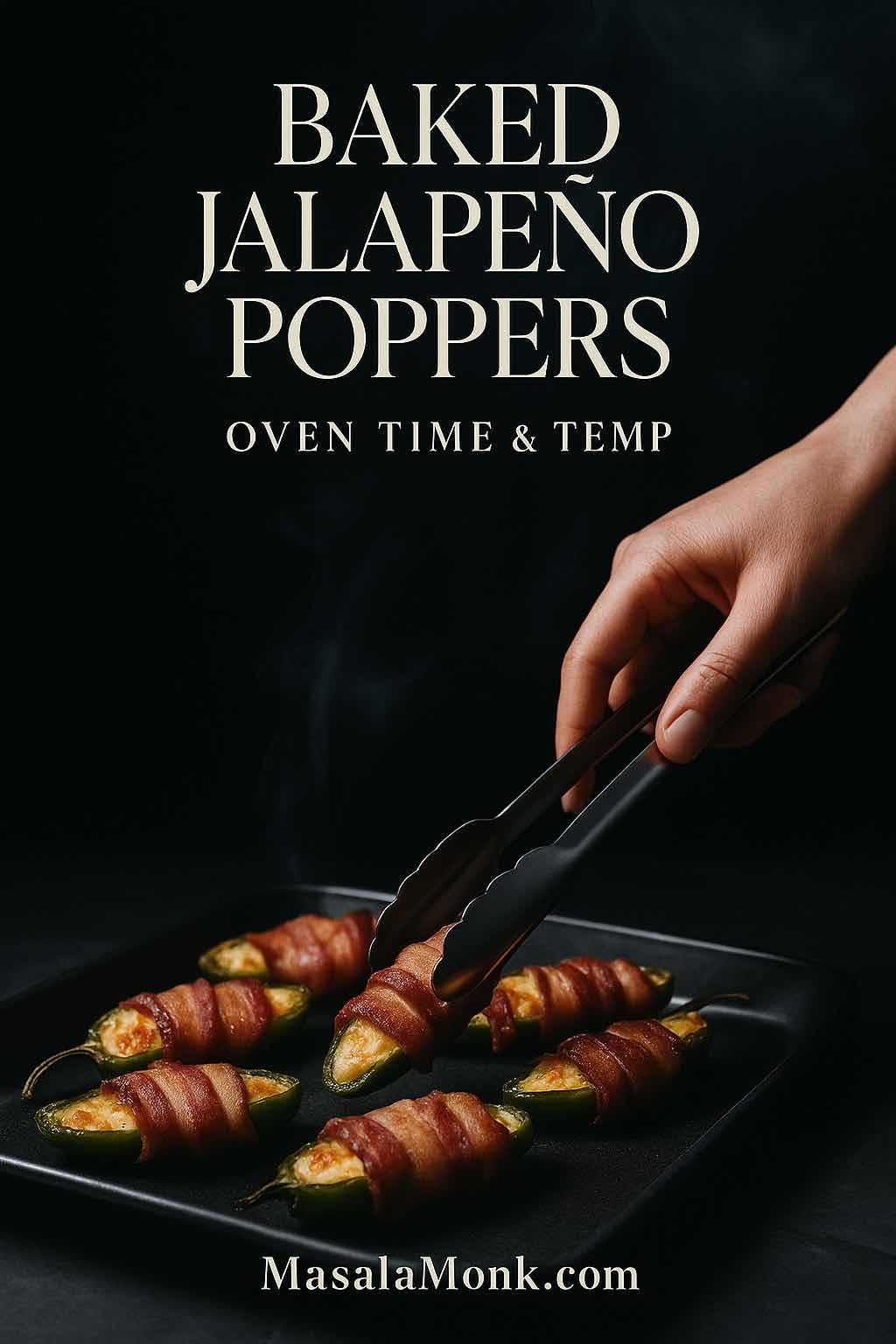
There’s a particular kind of party food that somehow disappears the moment the tray lands on the table. Baked jalapeno poppers are that food—spicy, creamy, crisp around the edges, and just messy enough to feel celebratory. Instead of deep-frying, we’ll rely on the oven (and, if you like, a quick finish on the grill or under the broiler) for a version that stays crunchy where it should and melty where it counts. Along the way, you’ll get precise time and temperature cues for plain and bacon-wrapped jalapeño poppers in oven, clever variations, and a handful of drink pairings that make every bite pop.
Before we jump in, a quick word on method: because the oven is less aggressive than a fryer, we’ll engineer crispness with smart setup—wire rack, middle rack placement, proper spacing, and (optionally) a light panko top. This combination delivers the sought-after contrast: tender pepper, hot filling, and a lightly golden cap you can tap with a finger.
Also Read: How to Cook Bacon in the Oven (Crispy, No-Mess, Crowd-Ready Recipe)
The Roadmap (What You’ll Do, in Spirit)
First, split the jalapeños lengthwise. Next, scoop out seeds and ribs (leave some ribs if you want a little sting). Then, stir together a balanced filling—cream cheese for structure, sharp cheddar for pull, scallion for freshness, garlic for warmth, a pinch of salt to wake everything up. After that, pipe or spoon the filling into the pepper “boats.” Finally, either bake them as-is or wrap each with thin-cut bacon, setting the halves seam-side down so the wrap tightens as it cooks.
Although that sounds almost too simple, the difference between good and great lives in the details. A wire rack over a sheet pan is essential: rendered fat and vegetable moisture drip away, heat surrounds the peppers, and the bottoms crisp instead of steam. And yes, a quick sprinkle of panko creates a crackly top without cumbersome breading—Serious Eats has long championed oven-crisp poppers and even suggests techniques like a brief chill to keep fillings tidy. See their crispy baked jalapeño poppers method for why this works so well. (Serious Eats: Crispy & Gooey Baked Jalapeño Poppers)
Also Read: French Toast Sticks (Air Fryer + Oven Recipe) — Crispy Outside, Custardy Inside
Here’s the baseline method for baked jalapeño poppers—time, temp, and the rack setup that keeps them crisp.
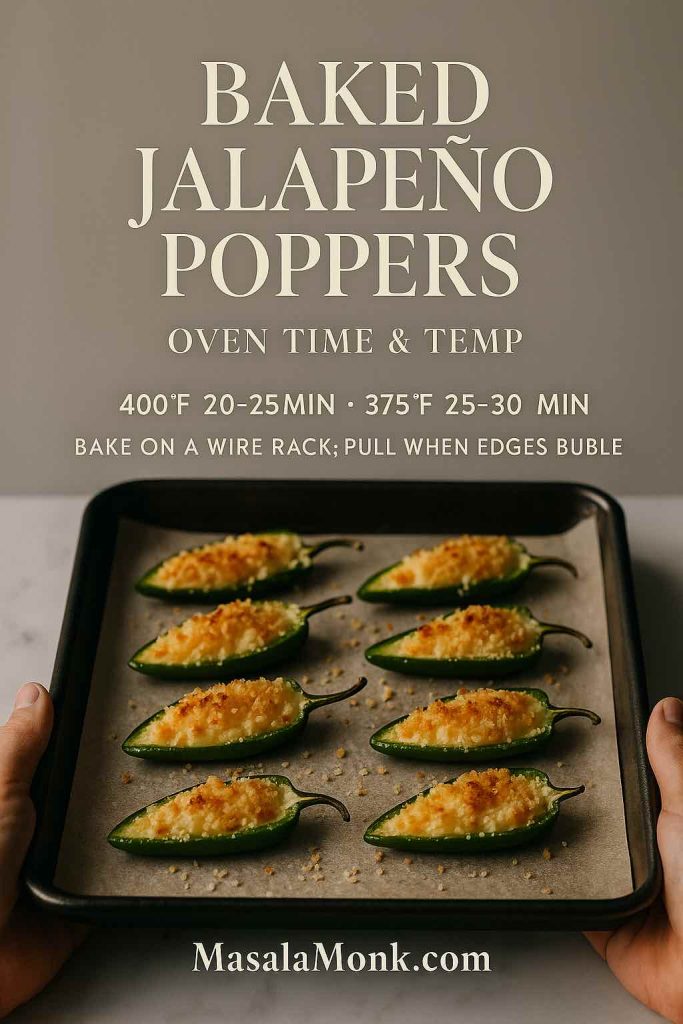
Baked Jalapeno Poppers: Oven Time & Temp (Your Baseline)
Because jalapeños vary—some are slender and fiery, others plump and mild—cook times flex. Nevertheless, a reliable pattern emerges:
- 400°F (204°C): about 20–25 minutes for plain baked poppers.
- 375°F (190°C): roughly 25–30 minutes, especially for larger peppers that need a more gradual cook.
Importantly, doneness cues beat the clock every time: look for a lightly golden top, bubbling edges where the cheese meets the pepper, and a pepper wall that yields to a fork without collapsing. If you opted for panko, a slightly hotter oven helps the crumbs set fast; if you skipped crumbs, stay anywhere in that 375–400°F lane and track the visual signs. For more on oven-based technique, you can cross-reference this test-driven baked poppers approach. (Serious Eats: Crispy & Gooey Baked Jalapeño Poppers)
Also Read: Air Fryer or Air Fryer Toaster Oven: Making the Right Choice
Why Panko Helps (Without Going Full Breaded)
Now, you could dredge and bread, but that’s overkill for an oven method. Instead, sprinkle a little oiled panko on top; the large, airy flakes brown quickly and stay crisp. Panko’s structure (bigger flakes, more surface area) is the real reason it works so well for light oven crunch. If you’d like a deeper dive into why those crumbs behave differently, skim this primer on what panko does in high-heat applications. (Serious Eats: Everything You Can Do With Panko)
Bacon-Wrapped Jalapeño Poppers in Oven (Time, Temp & Finish)
For bacon-wrapped, use thin-cut slices and the timings below; finish hot for snap.

Because bacon needs time to render, bacon-wrapped jalapeño poppers in oven take a touch longer. Furthermore, thin-cut bacon is your friend here: it renders faster, tightens beautifully, and crisps without overcooking the pepper. Consequently, aim for:
- 400°F (204°C): about 25–30 minutes.
- 375°F (190°C): approximately 30–35 minutes.
Afterward, if you want a final snap, broil for 60–90 seconds, keeping the tray on the middle rack so the bacon doesn’t leap from crisp to scorched. Prefer smoke instead of broil? As an alternative, a pellet grill or smoker gives you that campfire flavor with very little effort: many cooks smoke at a low setting for about 30 minutes, then raise the heat to around 375°F to finish until the bacon is as crisp as you like. Traeger’s step-by-step method follows that exact logic—low smoke, then hot finish—so you can use it as a cross-check. (Traeger: Smoked Jalapeño Poppers)
If the grill calls your name instead, indirect medium heat (think a covered grill with the poppers off the direct flame) usually lands you in the 20–30 minute window, after which a quick kiss of direct heat crisps the bacon edges. Weber’s popper playbooks outline both grilled and smoked takes, complete with setup notes you can mirror on gas or charcoal. (Weber: Smoked Jalapeño Poppers; Weber: Grilled Jalapeño Poppers)
a quick safety nudge: bacon should be handled cold, cooked once, and cooled promptly. for storage windows (and a handy chart you can cite in your notes), the USDA FSIS has clear guidance on bacon handling and leftovers. (USDA FSIS: Bacon & Food Safety)
The Cleanest Base Recipe of Baked Jalapeño Poppers
You’ll need: fresh jalapeños, cream cheese, shredded sharp cheddar, scallions, garlic, fine salt, optional panko, and thin-cut bacon if you’re wrapping.
- Prep the peppers. Halve lengthwise; scrape seeds and ribs with a small spoon. For milder poppers, remove everything; for a gentle tingle, keep a little rib in place.
- Mix the filling. Beat the cream cheese until spreadable; fold in cheddar, scallion, and garlic; season lightly.
- Fill confidently. Spoon or pipe; keep the filling just proud of the rim (too much will ooze). If you’re wrapping, tuck the bacon seam underneath.
- Set the stage. Line a sheet pan with foil for easy cleanup; place a wire rack on top; spray lightly. Arrange peppers with space.
- Bake by cues. Use the time/temps above, but trust your eyes: bubbling edges, tender pepper walls, light golden tops.
- Finish with intention. Broil briefly for bacon crisp; or, if you’ve got a lit grill, slide the rack on for a minute per side for faint smoke and char.
Because you might be like to try some variations without redundancy, here are a few ideas that change the feel without changing the base.
Variations of Baked Jalapeño Poppers
Panko-Crisp Cap. Toss panko with a touch of oil or melted butter, then sprinkle sparingly before baking. It’s just enough texture to crackle without hiding the pepper. For a rationale rooted in testing, see why panko’s larger shards resist sogginess. (Serious Eats: Panko Guide)
Cheddar-Forward Filling. Increase sharp cheddar for melt and salt; balance with extra scallion. Because cheddar tightens as it melts, leaving a little headspace helps prevent spillover. For ideas on alternative coatings or fillings (including pulled pork for a smoked spin), peek at this pulled-pork poppers riff. (Serious Eats: Pulled-Pork Jalapeño Poppers)
Grilled Finish (No Bacon). Bake until nearly done, then finish on a hot grill grates for 1–2 minutes to add a whisper of smoke. Weber’s jalapeño guides show indirect setups that minimize flare-ups while you get that last bit of char. (Weber: Jalapeño Poppers)
Cook indirect to tender, then kiss with direct heat for the crisp finish.
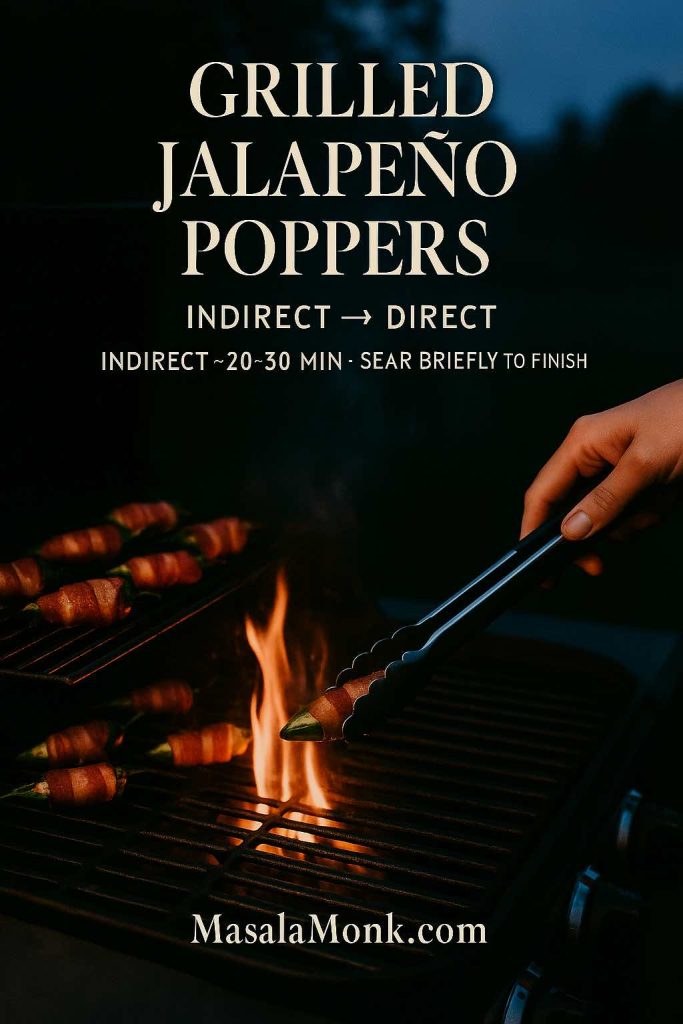
Smoked, Then Crisped. If you’re hosting outdoors, smoke the tray for 30 minutes on low, then raise heat to 375°F until the bacon is just right. Traeger’s method lays out that two-stage approach clearly. (Traeger: Smoked Jalapeño Poppers)
Low smoke, then hot finish—use this two-stage rhythm for perfect texture.
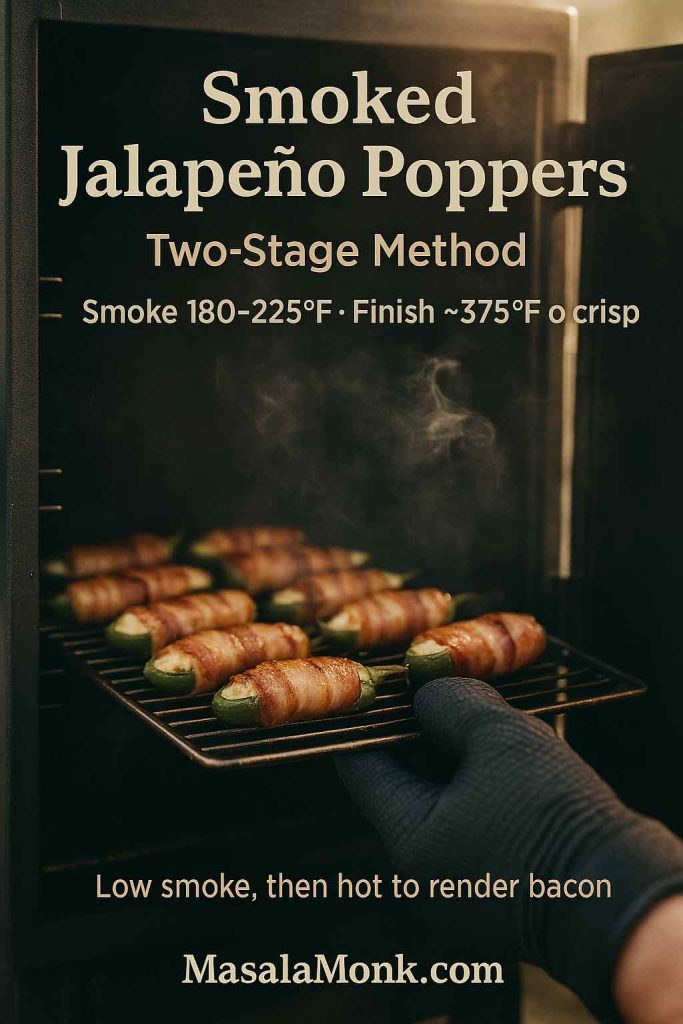
Air-Fryer Shortcut (Small Batches). On weeknights, the basket can be a lifesaver. In that case, preheated around 370–380°F, you’ll usually see 7–10 minutes for plain poppers and about 10–14 minutes for bacon-wrapped, with a flip halfway. For a published reference that mirrors those times and cues, here’s a reliable kitchen resource. (The Kitchn: Air Fryer Jalapeño Poppers)
Weeknight quick? These air-fryer times get you color without crowding the basket.

Jalapeño Popper Bake (Casserole). All the popper flavor in a crowd-friendly dish—brown the top under the broiler.
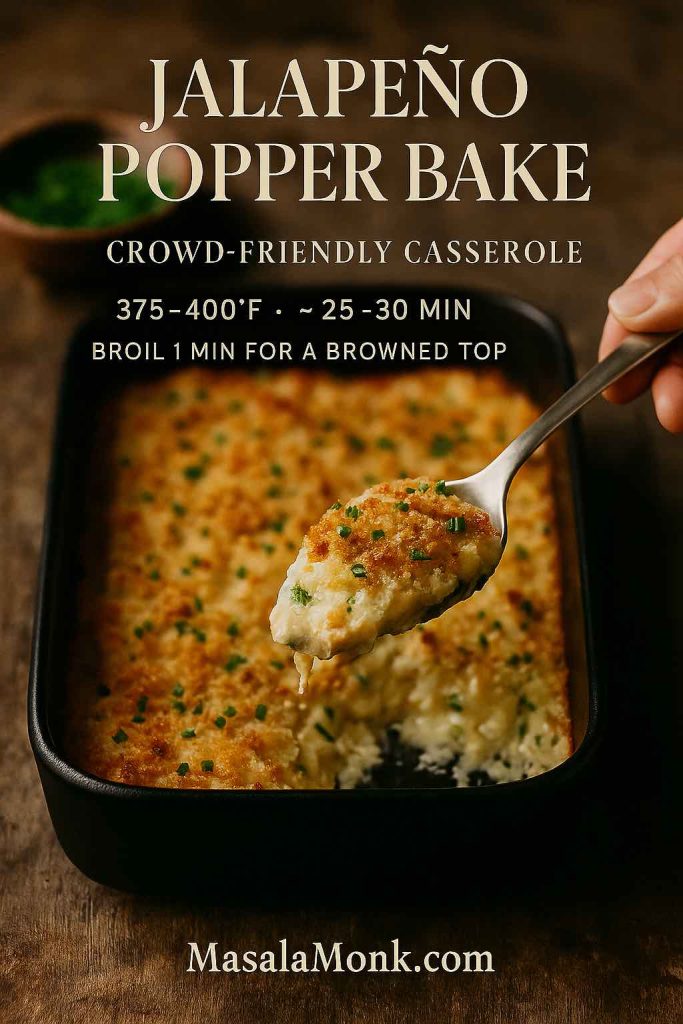
Serving: Contrast, Then More Contrast
Since poppers are rich and salty—and, with bacon, downright luxurious—pair them with drinks and sides that cut through. Naturally, you’ll want variety on the board, but more importantly, you’ll want balance in the glass.
Bright, savory-tangy refreshers. When bacon’s on the tray, the savory sparkle of Jal Jeera (an Indian cumin-mint lemonade) does magical things; it’s zippy, cooling, and distinctly moreish alongside spicy bites.
Tropical, minty coolers. For a crowd pleaser that never fights the food, mix Pineapple Mojito Mocktails; add ginger if you want a light snap that stands up to bacon fat. On a sweeter note—though still bright—Mango Lemonade settles the heat without weighing down the palate.
Creamy, tangy dip to reset the palate. A cool blue cheese dip pairs as naturally with poppers as it does with wings: the funk and acid balance heat, while the thickness reins in drips and crumbs.
Something hearty on the side. Because the spicy-creamy combo begs for a neutral foil, toss a tray of crisped tubers into the mix; you can swipe them through stray cheese and crumbs between bites. This roundup of potato appetizers is a helpful springboard.
Also Read: Air Fryer Chicken Wings (Super Crispy, No Baking Powder)
Technique Notes You’ll Use For Baked Jalapeño Poppers
Gloves and steam. Always seed jalapeños with gloves if possible; capsaicin sticks to skin. Meanwhile, after baking, let poppers rest 3–5 minutes so steam relaxes into the filling; that short pause prevents molten blowouts.
Rack, not pan. Elevation is everything. A rack allows hot air to circulate and keeps bottoms from stewing in their own juices. If you don’t have one, crumple long coils of foil into “rails” and set peppers on top—janky, yes, but effective.
Thin bacon wins. Because thick slices remain chewy by the time peppers are done, thin-cut bacon is the right call for the oven. If all you have is thick-cut, par-render it briefly on a rack in a hot oven, then wrap and finish on the peppers. For safe handling and storage windows, keep the USDA FSIS bacon guide bookmarked. (USDA FSIS: Bacon & Food Safety)
Breadcrumb restraint. A little panko goes a long way; too much turns the bite into a crust with a pepper attached. Oil the crumbs lightly so they brown instead of drying out. If you’re nerdy about why panko behaves the way it does, this explainer is a quick, satisfying read. (Serious Eats: What to Do With Panko)
Alternate heat sources. If you’re grilling, aim for indirect heat to start; once the pepper softens and the filling bubbles, slide briefly over direct heat to toast the edges. Weber’s popper recipes show timing patterns (often 16–30 minutes total) you can translate to your setup. (Weber: Grilled Jalapeño Poppers; Weber: AU Jalapeño Poppers, 20–30 minutes indirect)
Smoker logic. Smoke likes time, bacon likes heat. Consequently, a two-stage approach—low smoke first, then a hotter finish—gives you both. Traeger’s versions document that climb from 180°F smoke to a 375°F finish until bacon is crisp. (Traeger: Smoked Jalapeño Poppers)
Air-fryer guardrails. Especially on small batches, the basket keeps things weeknight-friendly. Keep space between halves, flip once for bacon, and begin checking early; models run hot or cool by a few degrees. The Kitchn’s recipe lands around 7–10 minutes for plain poppers, and that aligns well with home testing. (The Kitchn: Air Fryer Jalapeño Poppers)
Flavor Tweaks Without Starting Over
Scallion swap. Chives create a softer onion note; minced pickled jalapeños add tang and echo the main pepper without extra heat.
Citrus lift. A micro-grate of lime zest over hot poppers brightens the whole bite; if you’re serving with Jal Jeera or Mango Lemonade, the citrus ties everything together.
Cheese balance. Cream cheese softens heat and prevents greasy leaks; cheddar adds savor and stretch. If you want a stronger punch, swap a little cheddar for smoked gouda or pepper jack, then rein in the salt.
Herb crunch. Minced cilantro and a dusting of toasted panko take the bite from creamy to layered without making it fussy.
Pulled-pork cameo. For a smoker day or a tailgate platter, tuck a teaspoon of pulled pork beneath the cheese; it eats luxurious and leverages leftovers. The inspiration isn’t new, but it’s timeless. (Pulled-Pork Poppers)
Make-Ahead, Leftovers, and Freezer Smarts
Assemble ahead. Filled, unbaked poppers chill beautifully. Cover and refrigerate overnight; bake from cold and add a couple of minutes until the same doneness cues appear. If you sprinkled panko, hold it back until right before baking so it stays perky.
After the party. Cool leftovers, stash airtight, and enjoy within a few days for best quality. When in doubt, reheat on a rack in a hot oven so bottoms crisp again. For freezer logic, the USDA FSIS notes frozen foods remain safe indefinitely, while quality has a practical window; as a reference point, bacon sits comfortably in the 1–2 month range for peak texture. (USDA FSIS: Freezing & Food Safety)
Batch strategy. If you’re cooking multiple trays, rotate pans halfway. Moreover, keep the rack in the middle position to balance top browning with pepper tenderness.
Re-crisp rescue. If bacon lost crunch in the fridge, bring poppers back to life at 425°F for a few minutes on a rack; broil briefly if needed, watching closely.
Also Read: Lemon Drop Martini Recipe (Classic, 3-Ingredient, & More)
When You Want a Show-Stopping Platter
Start with a mountain of baked jalapeño poppers—some plain, some bacon-wrapped. Then, surround them with a few high-contrast sides and sips. Slide in that blue cheese dip for tang, pour a pitcher of Pineapple Mojito Mocktails for brightness, and add a bowl of potato appetizers for an easy, neutral foil. Or, for a more savory-spicy lean, pour tall glasses of Jal Jeera and let the cumin-mint twist do the heavy lifting between bites.
Troubleshooting Baked Jalapeño Poppers
Soggy bacon? Use thinner slices, keep the rack elevated, and finish hot. Alternatively, grill briefly over direct heat right at the end; Weber’s popper recipes show how to move from indirect to direct without flare-ups. (Weber Grilling Inspiration)
Leaky filling? Don’t overfill, and if you’re wrapping, place the seam under the pepper. In addition, a quick 10-minute chill helps the filling set up before baking—a tip baked (pun intended) into many test kitchens’ workflows. (Serious Eats baked poppers)
Too spicy? Remove every last seed and rib; then up the cream cheese and add a drop of honey or a spoon of cooled, mashed potato to the filling—both tame heat without turning the bite into dessert. Finally, pour Mango Lemonade alongside for a sweet-tart buffer.
Not tender yet? Give the peppers 3–5 more minutes; the sweet spot is when the wall yields easily but still holds its shape.
Also Read: 10 Best Chicken Sandwich Recipes (BBQ, Parm, Buffalo & More)
Wrap It Up (and Bake)
Ultimately, baked jalapeño poppers are all about contrasts done right: hot and cool, creamy and crisp, spicy and refreshing. With an oven-first method, a few small tricks (rack, spacing, panko), and dependable timing for both plain and bacon-wrapped jalapeño poppers in oven, you get consistent results without baby-sitting oil. And if you feel like leveling up, you’ve got options: a smoke-then-crisp routine on the pellet grill, a quick detour across hot grates for whisper-char, or an air-fryer sprint for weeknights.
Now, line a tray, grab those peppers, and claim the last popper before someone else does.
FAQs
1) How long to bake jalapeño poppers at 400°F?
At 400°F, baked jalapeno poppers without bacon usually finish in about 20–25 minutes, while bacon-wrapped poppers tend to need 25–30 minutes. Moreover, pull them once the tops are lightly golden, the filling bubbles at the edges, and the peppers feel tender yet hold shape.
2) How long to bake jalapeño poppers at 375°F?
At 375°F, plain poppers generally take 25–30 minutes and bacon-wrapped versions about 30–35 minutes. Additionally, rotate the pan once so color develops evenly across the tray.
3) How long to bake jalapeño poppers at 350°F?
At 350°F, expect a gentler cook: 30–35 minutes for plain and 35–40 minutes for bacon-wrapped. Consequently, if you want extra browning after they’re tender, finish with a brief broil while watching closely.
4) What oven temperature works best for baked jalapeno poppers?
A range of 375–400°F is the sweet spot for consistent results. Notably, 400°F crisps faster, whereas 375°F gives larger peppers and heavy fillings a more even cook.
5) How long to cook jalapeño poppers in the oven overall?
Most trays land between 20 and 35 minutes depending on pepper size, filling volume, and temperature. Ultimately, remove them when the cheese is bubbling and the pepper walls yield to a fork without collapsing.
6) How to keep bacon crisp on bacon-wrapped jalapeño poppers in oven?
Thin-cut bacon and a wire rack make the difference by letting fat render and drip away. Likewise, baking hot on the middle rack and finishing with a short broil locks in snap without overcooking the peppers.
7) How to bake stuffed jalapeños (no bacon) so the filling doesn’t leak?
Keep the filling just proud of the rim rather than mounded, then chill the filled peppers for about ten minutes. Furthermore, a light sprinkle of oiled panko helps the surface set quickly.
8) What’s the best cheese mix for baked jalapeno poppers?
Cream cheese provides body and prevents greasy leaks; sharp cheddar adds savory pull. Conversely, if you want a bolder bite, swap in a little smoked gouda or pepper jack and adjust salt.
9) How long to bake jalapeño poppers with panko on top?
In a 400°F oven, plain poppers with a panko topper usually finish in 20–25 minutes, while bacon-wrapped need roughly 25–30. Additionally, oil the crumbs lightly so they brown instead of drying out.
10) What’s the simplest way to reheat baked jalapeno poppers?
Re-crisp on a rack at 400–425°F for a few minutes until the tops liven up again. Alternatively, avoid microwaving, which softens crust and bacon.
11) How long to bake jalapeño poppers wrapped in bacon at 400°F?
Plan about 25–30 minutes on the middle rack for bacon-wrapped jalapeños. Importantly, thicker bacon may require a minute or two of broil to finish rendering.
12) How long do extra-large jalapeño poppers take?
At 375°F, oversized peppers often need 30–35 minutes; at 400°F, start checking around 25–30. Moreover, test tenderness with a fork and extend time in small increments.
13) What temp to cook bacon-wrapped jalapeños if I want gentle heat?
Choose 375°F for more control over pepper softness and even rendering. Subsequently, if you’d like sharper crisp, raise to 400°F for the final few minutes.
14) How long to cook jalapeño poppers in air fryer (plain and bacon)?
Plain poppers at roughly 370–380°F typically take 8–10 minutes, while bacon-wrapped at about 360–370°F run 10–14 minutes with a flip. Nevertheless, check early because basket crowding and model variance change browning speed.
15) How to cook bacon-wrapped jalapeños in oven without soggy bottoms?
Elevate everything on a wire rack so heat circulates and drips fall away. Similarly, give pieces space; overcrowding traps steam and softens the bacon.
16) How to bake stuffed jalapeños so peppers stay tender, not mushy?
Bake on the middle rack uncovered and stop as soon as a fork slides in with slight resistance. Thereafter, rest a few minutes so steam settles into the filling rather than making the walls limp.
17) How long to bake jalapeño poppers if I’m using thick bacon?
Expect 35 minutes or a touch more at 375°F, depending on thickness. Alternatively, par-render the bacon briefly before wrapping to shorten the final bake.
18) How far ahead can I assemble baked jalapeno poppers?
Assemble up to one day ahead and refrigerate tightly covered. Additionally, bake from cold and add two to three minutes until the same visual cues appear.
19) How long to bake jalapeño popper “casserole” or bake?
In a shallow dish at 375–400°F, estimate about 25–30 minutes until the center bubbles. Afterward, broil briefly for a browned top and rest several minutes so slices hold.
20) What’s the best rack position for even results?
Use the middle rack to balance top browning with pepper tenderness. Similarly, if you’re running multiple trays, rotate positions halfway through.
21) How to cook jalapeños wrapped in bacon on the grill without flare-ups?
Set up indirect heat first and cook until nearly done, then kiss with direct heat to crisp edges. Moreover, keep the seam underneath and use toothpicks sparingly.
22) How long to cook jalapeño poppers in the air fryer when they’re thick and crowded?
Start around 10–14 minutes for bacon-wrapped at 360–370°F but reduce the load for better airflow. Consequently, smaller batches brown more reliably and finish on time.
23) How long to bake jalapeño poppers with bacon bits instead of wrapping?
At 400°F, 20–25 minutes typically does it since there’s no strip to render. Additionally, sprinkle bits over the filling before baking for quick porky flavor.
24) What’s the ideal way to store and re-crisp leftovers?
Cool promptly, refrigerate airtight, and re-crisp on a rack in a hot oven just before serving. Hence, bottoms stay firm and the top regains texture without drying out the pepper.
25) Baked jalapeno poppers: what visual cues mean “done” regardless of time?
Look for bubbling cheese at the edges, lightly golden tops, and pepper walls that are tender but upright. Thus, even if clocks vary, those indicators guarantee the right bite on both plain and bacon-wrapped jalapeño poppers in oven.











